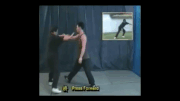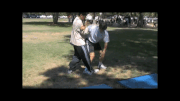Not really.
You're one of the Wing Chun people upset by his book, aren't you?
Yes, really.

I would suggest you read what I wrote again very carefully and consider the points I made. You are not making any arguments to counter the issues I raised, so your statement is - as of now - just unfounded opinion.
And...
What gives you the impression that I am upset by this book?
The passage of my post which you quoted, does not - again, I suggest you read more carefully what I wrote before drawing conclusions - relate to Mr. Judkin's book, but his main source of information about Gung Fu in Fatsaan, the "Fatsaan Martial Arts Culture". I wrote this quite clearly. You seem to have missed the point of what I wrote and why I wrote it...
There are a lot of folks in the Wing Chun community that dispel the many wuxia, magical realism origin myths, and that number is growing.
Applying critical analysis and critical thinking, levelling some well founded criticism at academic works does not imply being upset, it simply implies actually thinking about the material presented, instead of simply accepting that what I read is fact or "the truth". It does not mean that one believes in any of the things you quoted.

Next question, why would I be upset about a book, and especially what is presented in Mr. Judkin's work?
There is absolutely nothing in this book which was in any way new to me, in fact I found it very lacking in substance about Wing Chun and its development. Like I said, he is limited by his sources which, when it comes to actual Wing Chun relevancy are very, very few. There is not one of these sources which I didn't already have in my personal library of martial arts books, or which I had not already seen in local libraries in Fatsaan and Gwongjaau at the time the book was published.
While the books and the sources might obviously impress some people, I am not - peoples' mileage vary.
I don't think Hunschuld or Jlq read the book. This is a very well researched historical scholarly work from a top tier university expert, published by SUNY, on the origins of the art.
Given the fact that I commended the scholarship of the book, but pointed out its weaknesses and limitations and provided a critical analysis of the main work he cites when it comes to Wing Chun and its development in Fatsaan, you conclude that I must not have read the book? I think that is a pretty weak, and more emotional conclusion than a rational one. Again, you might be very impressed by the work, but others less so. I guess the less you know, they more impressive you would find this work.
As far as reading the book, if you read what I wrote with less emotional investment in the matter, it should be pretty obvious that I have indeed read the book. In fact, I have read all the sources - and in most cases, where applicable - checked the sources of the sources quoted. As I wrote previously, there is nothing new to what he presents or sources.

Once again, I will point out that the scholarship, "scientific method" and presentation is impeccable, but it is not authoritative in any way because of the problems with the - very limited sources - he draws on when he actually discusses Wing Chun (Chapter4). I suggest you take a good look at those 90 references and check out which sources he drew on and to what extent. To put this in perspective: of 90 citations, 29 are from "Fatsaan Martial Culture" (Ma Zineng), 19 from "Roots and Branches of Wing Chun" (Leung Ting), 11 from Yip Chun and Tse, 10 from Yip Ching and Heimberger and 6 from Chu, Ritchie and Yu's "Complete Wing Chun". The rest are cited just once, mostly. D
So, while you might be impressed with the number of sources listed and think it is thorough and in-depth historical scholarship, as is evident from going through the citations list, it is anything but that. I suggest you do the work to count which works are cited in chapters 2 and 3 as well, when it comes to certain subjects and then reevaluate your statement about "well researched". It is not Mr. Judkin's fault, but as I said in my first post, he suffers from a lack of sources to draw on.
It is quite amusing that on the one hand you consider Mr. Judkin's book amazing and authoritative, but at the same time seem deride Leung Ting's work, and claim it to be "subjective", when it is in fact the second most integral source which is drawn on when it comes to the history and development of Wing Chun...

There's a whole range of mythbusting about various things Daoist, Shaolin, Ip family, which one would hope for in a scholarly work.
It will come across as kryptonite to the stereotype "Wing Chun Man", if he exists. And he does.
For someone like me who studies lots of styles and wants a sniff test, it's probably the best legit work out there today.
Like I said, there is nothing particularly new or revelatory in the book - from my perspective. In fact, there could have been much more mythbusting done if he had more access to local information instead of simply being an armchair researcher (I do not mean this in a derogatory fashion, but simply in the sense that he didn't do actual field research to produce new knowledge but instead relied on whatever textual material he had access to via his private collection and libraries, be the physical or virtual). For example, the exact years of Leung Jan's life and death, his family, his pharmacy, Leung Bik, etc. this is all known in Fatsaan, Hoksaan, Gwongjaau, etc. and has been for a long time. But because he didn't have access to this information, and it is not found in any of the books he had access to when preparing this work, he obviously had to rely on "old" and inaccurate stuff to draw his conclusions on. Again, it is not his fault, just a limitation caused by what sources he had access to.
In spite of the problems and limitations of the book, as I see them, I am still of the opinion that it is a must have book, it is definitely the best available of its kind, and very informative on an "entry level" for people interested in the subject. Just don't take anything in there as the final word, but a best attempt by the author(s) based on the sources available to them at the time. It is not in any way, shape or form "authoritative" or comprehensive.
I definitely agree with you that any "Wing Chun fundamentalists" will not appreciate when faced with the proposition that the stories they have heard in reality are anything but real, and there will be a certain resistance to accepting this fact. There are so many stories, so much misinformation and so much nonsense accepted as fact by different people these days, and unfortunately many people will defend this stuff with the fervor of a religious fanaticist, regardless of the magnitude and strength of evidence of the contrary to their specific beliefs.

Reading through your many posts, it is clear that you do study a lof of things, but I must say - absolutely no disrespect or offense intended - that most of this seems to be at a very superficial level. If you had really studied certain things in more depth, you would not connect the dots in the ways that you do it... You might convince people who are inexperienced and who haven't really studied the subject to believing that you really have a serious level of insights and understanding of it, but old hands and experienced people, such as hunschuld and others on this forum, recognize things for what they are.
Just my impression based on what you have posted in this forum, FWIW.

You say you study Wing Chun... I am curious what style you practice, under which Sifu, and for how long you have been practicing. Also, I remember reading that you were studying the Tiet Sien Kuen of the Lam family? If so, same questions.
Best regards


